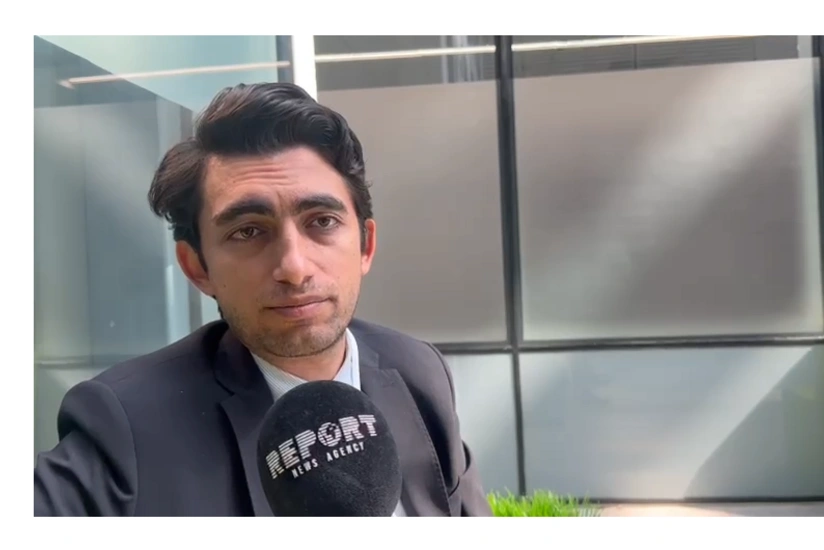Shahin Mahmudzada: Azerbaijan's Central Bank to implement system for overseeing greenwashing - INTERVIEW
- 03 October, 2025
- 12:43

The topic of green finance is taking an increasingly important place in the global financial agenda. Against the background of climate change challenges, the banking sector is gaining strategic importance in managing environmental, social and governance (ESG) risks, as well as developing sustainable financing instruments.
Azerbaijan is coming forward with new initiatives in this direction, actively expanding participation on international platforms and aims to increase the share of green financing in the banking sector.
Director general of the Central Bank of Azerbaijan, Shahin Mahmudzada, in an interview with Report, spoke about the green finance strategy, the banking sector's goals for the coming years, risk management, and prospects for international cooperation.
- What roadmap is the Central Bank implementing to develop green finance in Azerbaijan's banking sector?
- The Central Bank of Azerbaijan approved a Roadmap for Sustainable Finance in 2023 and publishes a separate report on its implementation annually. The document includes four key areas. The first is the development of human and infrastructure capital, that is, strengthening resources and competencies in the financial sector. The second is eliminating regulatory gaps by making changes to rules and legislation. The most significant results last year were achieved precisely in this area. The third area is risk management, which covers the integration of ESG risks into the risk management system, conducting stress tests, implementing digital solutions, and assessing potential losses for the financial sector. The fourth is strengthening market discipline through the introduction of disclosure standards and transparent reporting for the public. Within these areas, the implementation of a number of projects over three years is envisaged. At the end of next year, a new stage will be presented - "Roadmap 2.0". This stage will mainly cover the improvement of the existing framework.

- The Azerbaijani banking sector plans to allocate approximately 10% of its loan portfolio to green projects within six years. How realistic is this goal?
- According to the sustainable roadmap, responsibility for implementing these objectives lies not only with the Central Bank, but also with the Azerbaijan Banking Association and other financial associations. Last year, on the eve of COP29, the banking sector announced plans to invest 2 billion manats ($1.176 billion) in green financing. According to the latest data, approximately 300 million manats ($176.470 million) in green loans have already been issued in the first half of this year.
Today, banks are improving their underwriting standards for green financing, and ESG principles have become an integral part of strategic, business, and operational decisions. Regulation that takes market realities into account will significantly support the achievement of these goals. The allocation of 300 million manats in the first half of the year confirms that the banking sector is capable of allocating more than 2 billion manats to green projects over the next six to seven years.
- What incentives, such as tax breaks, government guarantees, or preferential credit lines, are provided to achieve these goals?
- It's wrong to limit the discussion solely to incentives. The main issue is ensuring that ESG risks don't create risks for the sector. Therefore, the Central Bank's task is to implement requirements for sound capital planning and oversee risk assessment.
Since ESG risks are essentially no different from other types of risks, the Central Bank applies prudential requirements to them. This can take various forms: capital structure requirements, incentive mechanisms for certain types of activities, or additional prudential standards. Therefore, we're not talking about direct incentives, but rather about the need for ESG risks to be strictly monitored, and for the financial sector to bear responsibility for risk mitigation.

- How are potential impacts of climate change and environmental risks on financial stability evaluated?
- The peculiarity of ESG risks is that they affect financial stability more indirectly. While credit, interest rate, currency or liquidity risks can manifest in the short term, ESG risks typically materialize over 15-20 years and require long-term capital planning. For example, the reduction in real collateral value or declining company revenues due to decreased demand for their products increases credit risk. Changes in the price of bonds and other financial instruments of companies ignoring ESG factors can intensify interest rate risks. Thus, the key feature of ESG risks lies in their indirect and long-term impact. Nevertheless, they are just as significant for financial stability as other types of risks.
- How can increasing green financing affect risk diversification in the banking sector?
- The growth of green financing increases banks' resilience to ESG risks. Increasing the volume of green investments reduces the probability of ESG risks, improves the quality of credit portfolios, and strengthens financial stability. Thus, green financing plays a key role both in risk diversification and risk reduction.
- What is the level of foreign investors' interest in green financing initiatives of Azerbaijan's banking sector?
- When working with Azerbaijan's financial sector, foreign investors already want to see ESG elements in underwriting conditions. All leading banks strive to consider these criteria in cooperation with foreign partners. This is not a unique situation for Azerbaijan - similar requirements apply in other countries, and our banking sector is also actively involved in this process.
- What control mechanisms is the Central Bank developing to prevent greenwashing risks?
- The Central Bank is developing special verification mechanisms to determine whether credit products actually belong to the green category rather than being merely formal in nature. To this end, human capital development programs are being implemented, and employees undergo international training. As part of ESG risk management, the probability of greenwashing will be separately assessed, and if necessary, the Central Bank will take appropriate measures.

- What steps are Azerbaijani banks planning to take to enter international green finance markets?
- The Central Bank is a member of the European Circular Bioeconomy Fund (ECBF), and through this platform, joint projects are being implemented with almost 100 countries. The initiative to harmonize green taxonomies, launched on the eve of COP29, will be presented at a new stage at COP30 in Brazil. In addition, there are plans to implement joint green finance initiatives among Turkic-speaking states. Despite that this sphere is still at an early stage of development and ESG risks remain, countries can achieve collective progress by exchanging experiences. The Central Bank of Azerbaijan actively participates in this process both at the regional and global levels.
- Banks are already issuing green bonds. Is the possibility of using other instruments, such as green sukuk, being considered?
- The Central Bank is working on creating a regulatory framework for sukuk instruments. At the first stage, it is important to form a traditional sukuk market, and only after that will it be possible to move on to discussing green sukuk. Since the necessary legal and regulatory framework is not yet in place, it is premature to talk about issuing green sukuk at this time.
